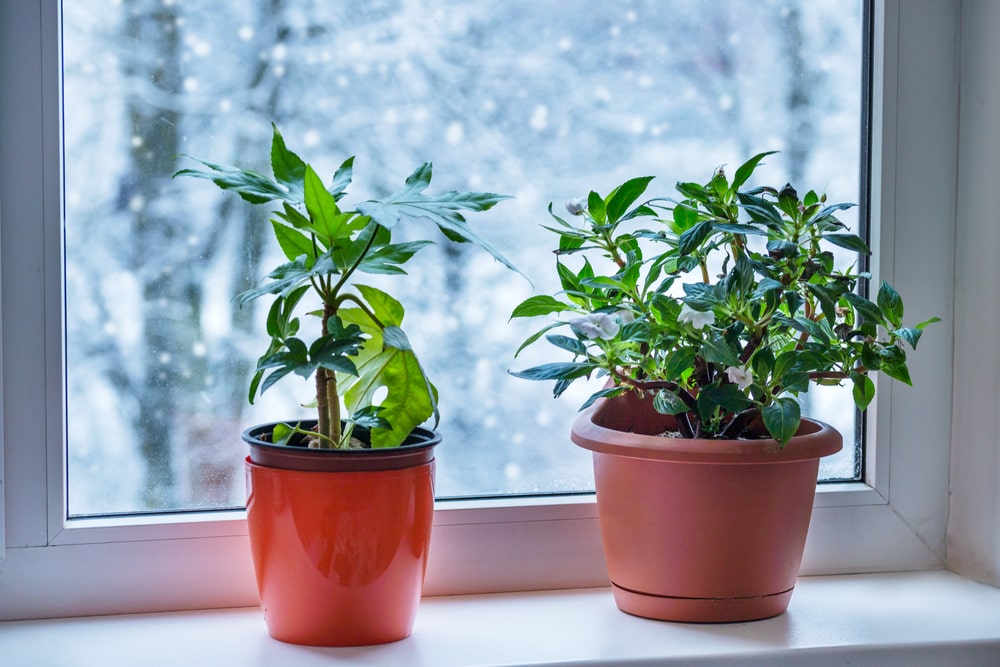Now that your houseplants have been inside for a couple of months, how are they doing? Here are a few things you might want to watch out for:
Yellow leaves
Yellow leaves can be a sign of three very different problems. When you first bring your plants inside, it’s a huge shock—losing leaves is a typical response. Providing everything else is okay, it should stop within a week or two.
If they continue to yellow, it’s often a sign that high-light-loving plants are not getting enough light—Weeping Figs and Citrus are famous for this. Moving to a window that gets some direct sun in the morning or later afternoon should help if this is the case. For Citrus, in particular, as much sunlight as possible is a good rule.
Yellow leaves can also occur if a plant has gotten too dry. A Peace Lily that has wilted, for example, will perk back up once you water it, but a couple of weeks later yellow leaves may show up.
Brown edges on leaves
Brown edges can also be a sign of two very different problems. On plants with delicate foliage, like ferns, the dry brown edges can be a sign the plant does not like dry indoor air. Putting a humidifier in the room or lightly misting the foliage every morning can help.
Brown edges can also be a sign of over-watering. We sometimes forget that plants need air as much as they need water. When the soil in a pot is allowed to dry out an inch or two down, it allows air back into the soil. Most plants need to be, at least, surface dry before watering. Some plants, like Ficus, Schefflera, and Citrus, should dry out several inches down—just not bone dry all the way to the bottom.
Remember cacti and other succulents are native to DRY deserts so allow them to dry almost all the way.
Clear sticky “sap” on foliage
Occasionally, some flower buds can secrete a little sap from the tip. If the sap is only on the buds and you don’t see any problems, like aphids, this may be what it is. Clear sticky sap on the leaves, however, could also be Honeydew. Honeydew is a secretion of certain sucking insects, like aphids, mealybugs, or scale. If it’s all over the lower leaves, etc. then an insect is probably the problem.
Examine the plant carefully for scale (little raised brown bumps that you can scratch off with a fingernail) or for mealybug, which looks like little bits of white cotton lint. Examine flower buds or tender new leaves for aphids that may be yellow, pale green, brown, or whitish. Scale, aphids, and mealies can be easily treated with horticultural oil.
Gnats flying around your plant
This is most likely fungus gnats. Fungus gnats are not actually hurting your plant, but they are annoying. Their larvae eat decaying organic debris in your soil and are a sign that your plants are staying too damp. Allowing the soil to dry an inch or two down will usually address the problem.
In the meantime, you can treat your soil with a water/bleach solution (4 tablespoons of bleach to one gallon of water that has been allowed to stand overnight). Pour through the soil until it runs out the bottom. This drench is also good for ants or slugs in the soil.
You can use sticky traps to catch the adults. If you don’t correct your watering, however, they will likely return.
Temperature shifts
Remember plants do not care for hot or cold air blowing directly on them so be careful about placing them near entrances or heating vents. If you have heating vents on the floor or in the ceiling, check at a hardware store for deflectors that will help direct the airflow out into the room.
We’re Here to Help!
Got anything else strange going on? Bring a sample of a leaf in for us to diagnose!

